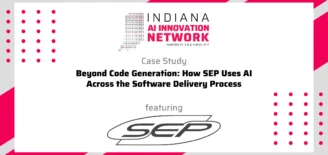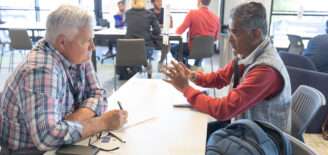Studio Science Q&A with Kristian Andersen
If you missed the fireside chat with Kristian Andersen during the Verge Studio Science Launch Party last month, you might still be wondering what the deal is with KA+A changing its name after a decade of building up a sterling reputation as a top-notch design and innovation shop — especially in the Indianapolis tech community.
It turns out, there were some good reasons for the name change. We caught up with Kristian and asked him a bunch of questions we thought our readers would want to know. From where the name derived to where their clients are located, and from “why Indy” to what is their obsession with starting new things, check out this Q&A with the founder of newly-named Studio Science!
KA+A is now Studio Science from Studio Science on Vimeo.
Over the past decade Indy’s entrepreneurs, designers, developers and business leaders transformed our backyard into one of the nation’s most vibrant hubs of technology, entrepreneurship, and innovation.
We all witnessed the emergence of a world-class innovation economy in Indianapolis and we’re proud to have participated in this city’s remarkable ascension. Our city, our partners and our people helped us take what started as a boutique design firm and build it into a global design and innovation consultancy.
The last decade was amazing….wait until you see what’s next.
KA+A is now Studio Science
QUESTION: Why did you decide to rebrand, and how did you land on the name Studio Science?
ANSWER: KA+A was founded over a decade ago as a boutique design studio, serving a wide variety of clients located in Indianapolis and the surrounding region. Over the years, our industry focus began to narrow to the point that we almost exclusively served high-growth technology companies. Interestingly enough, as our industry focus narrowed, our geographic focus expanded, and we found ourselves serving clients located across the country and around the world. We felt that our brand was no longer reflective of our focus, the breadth of service offering, or our geographic reach. As our ambition and success level grew, we felt that now was the time to reframe how we work, where we work, and who we work for.
Some people might be surprised that there is enough business to “exclusively focus on serving B2B SaaS, marketing tech and enterprise cloud companies.” Explain how this approach works for you.
We didn’t set out to focus on this market. It really came into focus for us over time. It’s difficult to get hard numbers, but suffice to say, it’s a big market, and it’s growing at a breakneck pace. Most (if not all) companies are slowly becoming technology companies. So in a funny twist, while narrowing our focus, we expect our actual market opportunity to grow substantially in the years to come. This is exacerbated by the fact that the line between consumer tech and business-focused tech continues to blur. Think about the parallels in how we allocate time between our personal life and our professional life and how we use tools that cross over between those two historically separate domains.
You do work for some well-known brands outside of the Indianapolis market. What does that mix look like these days in-market Indy vs. outside of Indy?
For the first time in the consultancy’s history, Studio Science’s growing list of clients includes more current out-of-state companies than in-state, including many that have a global presence. As a byproduct, local companies, like Lesson.ly, TinderBox and Sigstr, are further exposed to potential clients outside the region. We work with B2B SaaS, marketing technology and enterprise cloud companies located around the country and in most major technology markets, including Seattle, Portland, Boulder, Chicago, NYC, San Francisco, etc. We recently completed the rebrand for global data solutions company Return Path, which has more than 420 employees in 12 offices around the world and just announced a $35M funding round.
Did you ever get the feeling you should head to New York or the Valley to play in those ponds instead of building in Indy?
We really believe that being located in Indy is a competitive advantage. It’s a geographic platform that we’ve chosen to build our business on. It’s really not that different from choosing a technology stack. Every business needs a set of infrastructure, tools, frameworks and talent to build the business on, and Indy provided an ideal blend of all of those attributes.
We believe that we have an unfair advantage operating out of Indy given our access to top-tier talent, support and infrastructure in the B2B SaaS, marketing technology and enterprise cloud markets. The way we think about this is: If you want to build a world-class fashion brand, you’d naturally be drawn to NYC. The access and proximity to leading fashion houses, pattern makers, textile manufactures, retail channels, etc. is unparalleled. The same is true for Indy in the B2B Saas/marketing technology world. You’d be hard pressed to find a major metro more tuned to support those types of businesses.
Is there a secret sauce that makes your team such a good fit for tech branding?
We’ve been really intentional about swimming in our lane as a firm and that has really impacted how we recruit, train and retain talent. We are really intentional about who (and how) we hire. If there is one thing I could point to and say we really knocked out of the park, it would be our success in hiring the best talent. Everyone that works at Studio Science is passionate about technology, fluent in the language of business, obsessed with great design and has the heart of a servant. I think that combination has been the key driver of our success.
You really do like to start things, don’t you? What do you get out of pouring talent and resources into community support and movement initiatives?
The desire to create and serve is deeply woven into our culture. Those two attributes are core to entrepreneurship, and they are also core to community engagement. The same ambition that drives us to help entrepreneurs and business leaders build great companies also pushes us to engage our community in meaningful ways. At the risk of sounding trite, we really do get as much out of it as we put into it. Our investments flow back to us in the form of a strong culture, talent recruitment and the opportunity to impact the city and entrepreneurial community.
What makes a good customer? What should a tech firm expect when working with Studio Science?
At the heart of every great relationship is trust. Without question, the sooner we are able to develop a deep and abiding level of trust with a client, the sooner we’ll be able to deliver great work that really moves the needle for that business. Trust ain’t cheap though. Sometimes it can be bestowed upon you quickly – via great references or the observable impact of one’s work – but it typically has to be earned incrementally…over time.
When working with Studio Science, a client should expect to be challenged. Great work starts with the proper framing of a challenge. If you get that part of the process wrong, the odds of achieving a satisfactory outcome are pretty slim. It’s the most delicate part of the process, because typically a customer has a pretty well-defined pain point, which lends itself to a pretty stock remedy. The magic happens, though, when you really open up to how you frame challenge. We spend a lot of time trying to get to the “truth beneath the truth,” which requires some substantive upfront investment on the part of both the design team and the client.
What is your wildest dream for Studio Science? What will the headline be for your 2020 New Year’s letter/newsletter?
We’ve got some pretty big ambitions for the business. Our intent is to build a globally recognized design firm that is headquartered in Indy, while continuing to play a significant role in attracting the best businesses, talent and opportunities to the city.
More philosophically, we want to reshape the common understanding of the role of design and innovation in the context of business. There is a lot of great work being pioneered in this arena by firms like IDEO, Frog and Fahrenheit 212, but this evolution is still in its infancy. In the coming years, design is going to play an even more pivotal role in the creation of new industries, markets and business models. We’d like to have a say in how that all shakes out.


